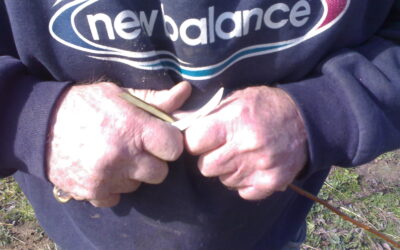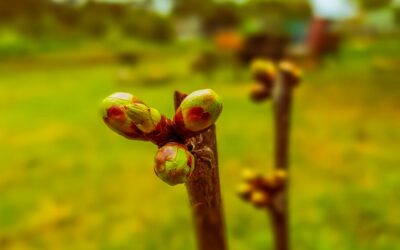Estimated reading time: 9 minutes
Multigrafts, double-grafts, ‘family’ trees, fruit salad trees, cocktail trees. There are lots of different names for them, but they’re essentially all the same thing.
Fruit trees with different varieties or cultivars grafted onto the same rootstock.
What’s the difference between a multigraft and a fruit salad tree?
Multigrafts have different grafts of the same fruit type, e.g., all apples.
A ‘fruit salad tree’ has different types of fruit from the same family, e.g., apricots and plums, peaches and nectarines, or pears and quinces. These trees are possible because generally speaking, fruits from the same family can be grafted onto the same rootstock.

However, due to the magic of grafting fruit trees, other combinations may also be compatible.
What fruits can you graft together?
For example, some varieties of peaches and nectarines are compatible with plum rootstocks. This allows for glorious combinations of 4 fruit types on the same tree – plum, apricot, peach, and nectarine.
While it’s safer to stick to known compatibilities, it’s always worth experimenting with odd and unusual combinations. Aside from your time, there’s minimal cost involved.
Multigrafts as art forms
One of the best ways to think about a multigraft is as a work of art that is “in progress”. A famous example is the ‘Tree of 40 Fruits’ Series by New York artist Sam Aken. You can see the artist’s rendition of one of these trees at the top of this blog.
Many problems that can happen with multigrafts (see the list below) are avoidable or fixable. When you’re creating the tree, you need to pay careful attention to graft placement and detailed pruning.
Then review the tree each year, and respond to how it has actually grown and performed each season.
The key to success with multigrafts is to think of your tree as a living work of art. Most gardeners use more of a ‘plant and forget’ approach.
Have high expectations of what you want to achieve with your multigraft. It’s possible to make them incredibly productive, as well as beautiful.

Can you graft multiple varieties?
Yes, absolutely—check out the family tree with 250 apple varieties in the pic above! There are lots of benefits of having multigrafts if you’re prepared to put the work into them.
Multigrafting has been used as a repository of the genetic material of lots of different varieties. It’s also a mark of the skill of the master grafter. It proves not only their grafting skills but also their superior pruning and management skills in keeping each separate variety alive and growing and keeping the whole tree in balance.
Another important benefit is that they allow you to increase your food security in a small space.
How does that work?
The more biodiversity that you can stack into your garden, the more you can protect your food supply. There are many disasters and natural events that can ruin a crop. If you’re growing 10 varieties of apple, rather than just one, then if a hail storm comes along or you get a particular disease outbreak, chances are that some varieties will fare better than others. This reduces your chances of total wipeout.
The more varieties you can play with in the garden, the more you can work towards a consistent, even harvest throughout the entire growing season. This is much better than the normal cycle of glut and scarcity that most home fruit growers deal with.
Other benefits of growing multigrafts include:
- pollination
- increasing food production in a small space
- practicing your grafting skills
- making the most of an existing tree with an established root system, rather than having to get a new tree established
What is the disadvantage of grafting fruit trees with multiple varieties?
- Inappropriate varieties: Not all varieties grow as well as each other in a given location. There’s a risk that some varieties you choose to graft won’t thrive, but, so what? Just regraft with another variety.
- Branch positioning: It is important that the grafted branches are evenly spaced along the main trunk. This produces a balanced form in the mature tree and avoids undesirable crowding. On a single-variety tree, a misplaced branch can simply be pruned off to allow well-placed branches to grow. However, pruning off any of the first branches of a multigraft tree may mean sacrificing one of the varieties.
- Pollination: Providing pollination partners is one of the main reasons for creating multigrafts. However, unless varieties are carefully chosen with this goal specifically in mind, it doesn’t always work. The varieties need to be compatible and also flower at the same time. In order for all varieties on a multigrafted tree to be pollinated, they must be carefully selected for flowering times to overlap sufficiently. Again, this problem, should it occur, is very fixable by regrafting with a more suitable variety.
- Management. Multigrafts are almost always a harder tree to manage in the garden, if you’re trying to keep the different varieties in balance with each other. They can be daunting for a new gardener in particular
Management of multigrafts
Pests and diseases
Different varieties can be vulnerable to different pests and diseases. In the worst-case scenario, the introduction of disease by one variety on a multi-grafted tree can compromise the health of the entire tree. This is particularly true if you accidentally introduce a virus to the tree by using infected grafting wood.
This is offset to a large degree by the advantages of increasing biodiversity, as we already mentioned. It’s good practice to only ever use grafting wood from trees with no visible signs of ill-health, and ideally a good record of productivity as well.
Keeping varieties in balance
Sometimes keeping the tree in balance doesn’t matter. For example, if you’ve grafted a different variety onto your tree to help with cross-pollination, you’re not aiming to grow both varieties in equal proportion.
But if you’ve planted a multigraft because (for example) you have limited space but still want roughly equal amounts of an early and a late apple, then for sure it matters.
There’s not a lot of point in having a multigraft Gala and Pink Lady if you get 10 boxes of Gala early in the season (when you already have plenty of plums and peaches), and then have to wait until the end of the season when you pick 2 Pink Ladys from one weakling branch!
So, how do you manage them?
Pruning
It’s a very common scenario that some varieties will be more dominant than others. This might be because the graft was of better quality or the variety is happier in the location. They may just be more compatible with the rootstock.
This can make it harder to train the tree into a balanced shape. The dominant branch will usually end up bigger and more vigorous. This needs careful management with pruning to prevent the dominant branches from shading out the weaker ones.
The trick is to pay a lot of attention to your pruning in the first few years of the tree’s life (which we call the ‘establishment phase’). Monitor closely how well the different varieties are growing. You may need to prune the more dominant variety back quite hard at the beginning. This will help the weaker side get equally established.
Of course, one of the pruning principles is that the harder you prune, the harder your tree is likely to grow, so the tree’s most likely response to hard pruning is that the dominant side will respond with even more gusto. You can minimise this bounce-back effect by pruning the tree in late summer, rather than winter.
Other management techniques
Another trick that might help if you don’t want to continually prune is to weigh the dominant limbs down more horizontally (e.g., with a brick).
This causes the height of the growth tip to be lower than the height of the weaker side of the tree. The extra physical height confers an advantage onto the weaker side, and the tree is more likely to direct more energy and resources to the weaker (higher tip) limb, allowing it to catch up.
Other issues with multigrafts
We have to talk about labeling. It almost seems too frivolous, but it’s probably one of the problems we hear about most regularly. This is true for all fruit trees, not just multigrafts!
It’s hard to find a good labeling system that can easily withstand the ravages of time and the weather. Labels must remain in place and also readable!
Our solution is to take a four-pronged approach:
- Make effective, permanent, low-cost labels by cutting up aluminium cans into labels. Use a nail (or a sacrificial pen) to etch the name into the metal. Punch a hole in the label and use a piece of wire to attach it to the tree. Don’t attach it too tightly around the branch or it’s easy to strangle the branch as it grows.
- Check the labels at least once a year. Make sure they’re still in place and still readable, and loosen the wire if necessary.
- Keep a paper (or computerised) record of the location of each tree. Write down the original variety, and any varieties you add by grafting.
- Take photos to back up the computerised record.

Are multigrafts and fruit salad trees worth the effort?
Absolutely!
If you’re interested in gardening and growing fruit, all of this is tremendous fun, both the grafting and pruning management.
It can be a quick way to experience the age-old relationship between farmer and nature (“who’s in charge here?”) that often starts as a battle for new growers but can end with a much deeper understanding and respect for how nature works.
And remember, the tussle goes on mostly in your mind – the tree will just keep being a tree.
Learning how to grow your own multigrafts can take a bit more work and diligence than single-variety trees. However, the benefits are huge. You can increase production, grow beautiful sculptural trees, and provide a life-long interest and passion.
But be warned – it’s addictive!
And if it all sounds like too much work you can buy pre-grafted multigraft trees from Carr’s Organic Fruit Tree Nursery
Related Articles
A good grafting knife…
A good grafting knife (and knowing how to keep it sharp) sets you up for grafting success as much as the techniques you need to master.
The top 4 fruit tree espalier mistakes to avoid
Espalier can be beautiful and productive way to grow your fruit trees—if you avoid these 4 common mistakes.
How to tell fruit buds from leaf buds
Understanding the difference between fruit buds and leaf buds on your fruit tree makes everything else about fruit growing easier.








I am interested in dwarf multi grafted trees where can I find them
Hi Sandra, if you’re in Victoria, we sell a range of multi-graft trees from our on farm nursery (Carrs Organic Fruit Tree Nursery) but the season has just finished up & we won’t sell trees until next year. If you’re further afield, we recommend Daleys nursery who stock some multi-grafts. Ultimately though, we recommend having a go at grafting yourself as it can be so satisfying! Let us know if you give it a go. Meg – Grow Great Fruit team.